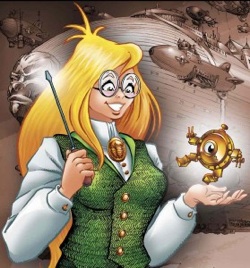Early on, when Phil and I had just begun to release Girl Genius, our book received a bad review. Specifically, the reviewer was unhappy that he couldn’t tell if our new comic was supposed to be science fiction or fantasy—we were clearly idiots who didn’t know what we were doing—we should have picked one and stuck with it, by damn. His point wasn’t that we were “mixing genres” poorly, it was that we were doing it at all. I puzzled over that one for a while, then just shrugged and wrote it off, concluding that the reviewer was clearly suffering from a crashing lack of imagination.
These days, I can’t help but remember that review, and wonder what the poor fellow makes of the current steampunk boom—with its cheerful disregard for the hard facts of real-world science, and the limitations they impose on writers of science fiction. Or, that is, the limits they would impose, if we were to pause in the middle of all the fun we’re having and let them.
In the last ten years or so, the word “steampunk” has come to mean far more than simply the literary subgenre of science fiction that, before the turn of the last century, lurked in the shadow of cyberpunk. Makers, visual artists, musicians, fashion designers, gamers, filmmakers, performers, culture historians, and even political thinkers have since joined the party. In many cases, these people had long been doing their own history-flavored retro-techno-fantastical work, and were surprised (and in many cases, delighted) to find themselves in a group of creative types of a similar bent, now classified as “steampunk.” We hear (and say) it over and over again, to the point where it has become a cliché: “I didn’t even know the word until someone used it to describe what I was already doing—what I already loved.” Or: “I knew I liked it, I always have, I just never knew what it was called.”
Phil and I are certainly two of those people—we’ve said just those things countless times, while giving interviews, chatting with other creators, or explaining ourselves to the curious readers who visit our table at conventions. (Officially, I still use the term “gaslamp fantasy” to describe Girl Genius. This saves me some time and grief, since, like any subculture or artistic movement, we have our share of people happily fighting about “what it all REALLY means.” Not slapping “steampunk!” all over my books keeps me from having to argue with them about whether or not we’re “doing it right.” They may be having fun arguing about what is and isn’t “proper steampunk,” I’ve got a story to tell. If it doesn’t fit into someone else’s box, well, so what? It’s mine.)
Still, whatever Girl Genius “is” or “isn’t,” I love steampunk. I sometimes imagine that I was very, very good in a past life, and I’m now being rewarded with a subculture and artistic movement based directly on my aesthetic sense. (I know I’m not the only one. Apparently, a whole bunch of us were really good. Who knew we had it in us?) Going to the conventions, seeing the incredible amount of love that people put into their clothing, costumes, gadgetry, and art of all kinds, is a huge treat for me. From a person whose living depends on other people buying her creative work, this may sound odd, but one of my favorite things about the steampunk subculture is its do-it-yourself attitude. Everyone involved is participating in the creativity in some way—whether they are making their own costumes, throwing theme parties, creating entertainment at a con, or simply spinning wild stories about the person they would be if they really lived in a world of mad science, adventure and airships.
Steampunk is not a group of children in a classroom, sitting quietly while the teacher reads a story, it’s the kids at recess, playing a wild, endless game of pretend. More than any other fandom I have experienced, there is something about steampunk that inspires direct participation, and huge enthusiasm. Over the years, I’ve heard a lot of people who don’t feel that they have it in them to do anything creative. They shrug and claim that they “have no talent.” They say things like: “Don’t quit your day job” or “Leave it to the professionals.” In the steampunk subculture, I don’t hear those things. I hear things like: “I’m learning how to do that” or “I’m going to try it.” The people who make up the steampunk movement are out there having fun, learning about odd points of history and technology, meeting people whose work they admire, and finding that they, too, can create beautiful things.
It’s a new age of discovery, and I’m glad to be a part of it.
Kaja Foglio is one of the creators of the Hugo-award winning comic Girl Genius: the ongoing story of Adventure, Romance, and Mad Science.










